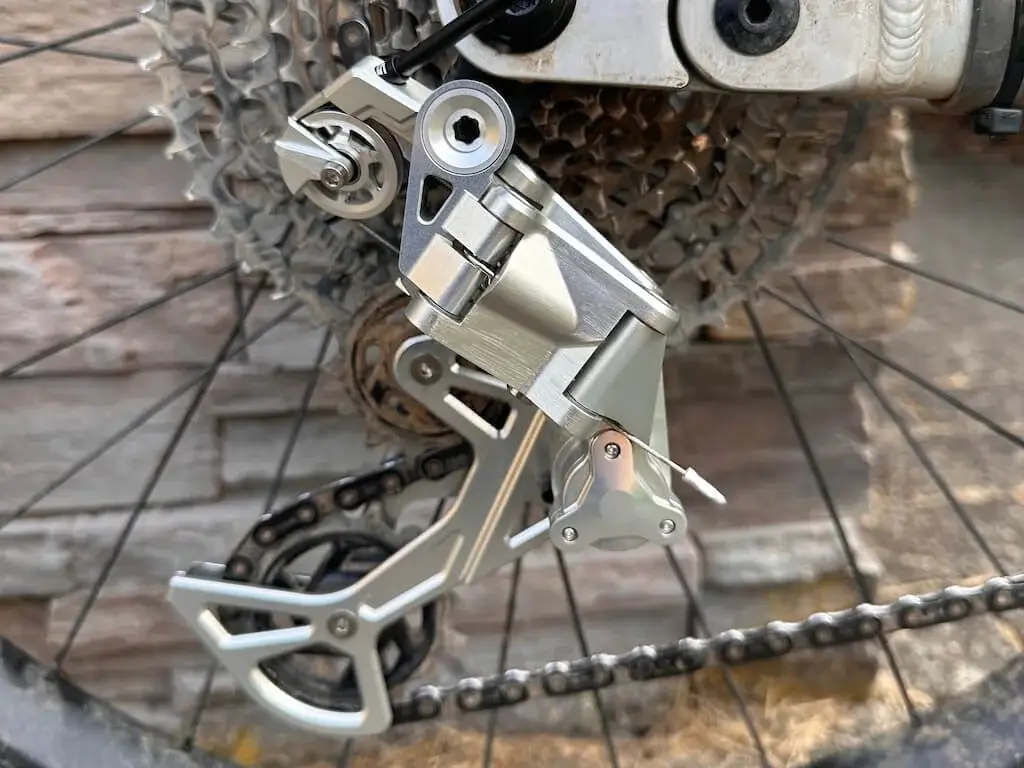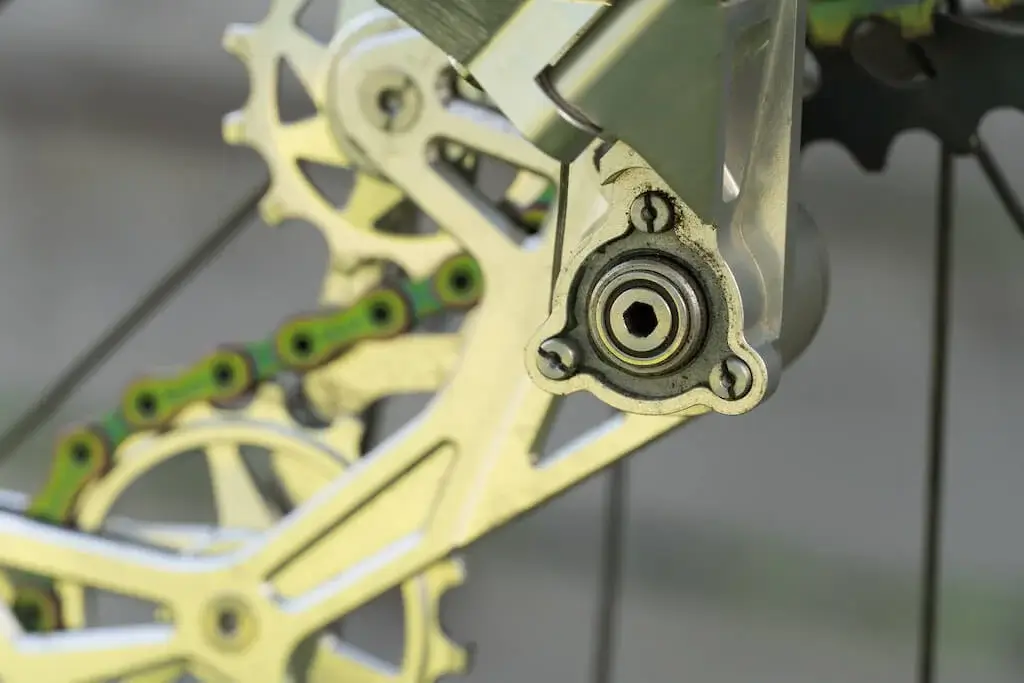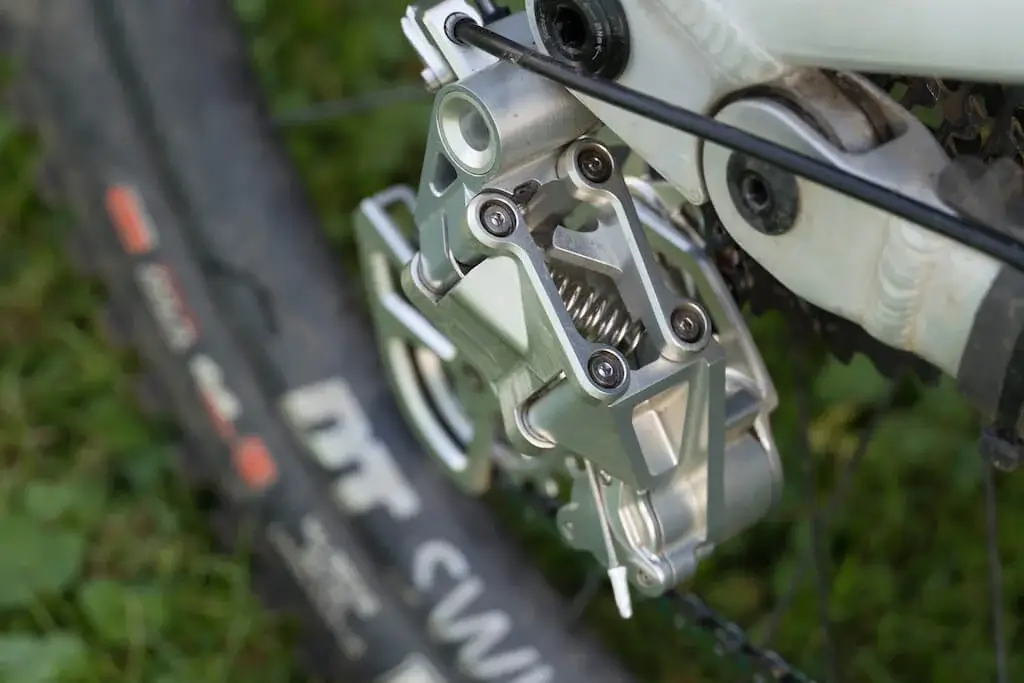In the world of mountain biking, wireless electronic drivetrains may dominate the conversation, but Vivo, a small company based in New York, has created a noteworthy alternative with their cable-actuated Enduro Derailleur and F3 Shifter. These precision-engineered components offer a unique blend of high-quality materials, customization, and durability, designed for riders who seek the perfect blend of function and flair. Let’s dive into the features, benefits, and performance of these components and explore why they could be worth their hefty price tag.


The Vivo Enduro Derailleur: Handcrafted Excellence
Precision Engineering for Serious Riders
The Vivo Enduro Derailleur stands out for its remarkable craftsmanship. Machined from 7075 aluminum, a lightweight yet strong material commonly used in aerospace applications, the derailleur is both durable and performance-oriented. Even the pulleys, which typically feature plastic in most derailleurs, are made of aluminum. To further enhance strength and longevity, titanium is used for the pivots and hardware, adding corrosion resistance and durability to the mix. At R6,600 (approximately $350), the Enduro Derailleur doesn’t come cheap, but it delivers quality and long-lasting performance.
Tailored for 12-Speed Drivetrains


Designed for 12-speed drivetrains with a 10-52 tooth range, the Enduro Derailleur can be paired with SRAM shifters (though not Shimano due to differing cable pull ratios). Vivo has made it compatible with most modern setups, ensuring that it can handle the rigorous demands of aggressive enduro riding.
F3 Shifter: Infinite Customization Possibilities
A Shifter Like No Other
The Vivo F3 Shifter, priced at R4,700 (around $250), is the derailleur’s perfect companion. Built with similar precision, the shifter boasts an array of machined aluminum and titanium parts, with the only plastic components being 3D-printed paddles, barrel adjusters, and the lower shifter housing. Vivo offers an astounding level of customization, allowing for over 30,000 permutations of the shifter’s components. Riders can choose from a wide selection of shift paddles, barrel adjusters, and back plates to perfectly tailor the feel and look of the shifter to their preferences.
Assembled in the USA with Global Contributions
While the assembly of both the Enduro Derailleur and F3 Shifter occurs in the United States, Vivo collaborates with multiple locations for machining and 3D printing. Some components are made in the US, while others are produced in China, ensuring a balance between high-end craftsmanship and efficient production.
The Performance: A Trail-Tested Experience
Installation and Setup
Installing the Enduro Derailleur on a bike, such as the Raaw Madonna used for testing, is a straightforward process. Vivo provides a guide to ensure the correct cable orientation, simplifying the setup even for non-professional mechanics. Once installed, the derailleur requires minimal adjustment, and its performance on the trail is where it truly shines.


Smooth and Crisp Shifting
On the trails, the F3 Shifter delivers a light, crisp action with an incredibly satisfying click each time you shift. It offers a tactile experience closer to SRAM’s mechanical shifters but with a lighter lever action. The gear transitions are precise, and despite a few personal adjustments to the thumb paddle, the overall experience is flawless.
Durability and Reliability
Built for rugged terrain, the Enduro Derailleur has proven its mettle in some of the harshest conditions. It remains solid and functional after extended use, with no play in the pivots or slop in the mechanism. Its all-metal construction means that it’s built to last, and Vivo has designed it to be easily rebuilt using standard tools, ensuring longevity for serious riders.
Customization vs. Competitors
While Vivo’s products are top-notch, they do come at a premium compared to other brands. Here’s a quick comparison to give you an idea of how they stack up:
- Vivo Enduro Derailleur: 331 grams, R6,600
- Vivo F3 Shifter: 128 grams, R4,700
- Shimano XTR Derailleur: 240 grams, R5,160
- SRAM XX1 Derailleur: 269 grams, R6,100
Vivo’s products are heavier than Shimano’s XT and SRAM’s XX1 options, but they offer a level of durability and customization that these mass-market alternatives don’t. The question is whether these premium features justify the extra weight and cost for your style of riding.

Durability Over Time
Built to Withstand the Elements
The Enduro Derailleur continues to operate smoothly after months of riding without any major adjustments. Its clutch system effectively prevents chainslap, and the friction clutch has remained consistent. While Vivo’s attention to detail is evident in every component, there is one minor downside. Adjusting the clutch tension requires removing three tiny bolts using a 1.3mm hex wrench—an unusual tool for most riders, unless they’re already working on intricate mechanical projects. Despite this, Vivo’s robust engineering means that it’s built to endure challenging rides for years to come.
Innovative Hacks: Going Wireless without Batteries
During testing, the Enduro Derailleur was used with a SRAM T-Type chain and cassette. Interestingly, this combination worked perfectly despite the absence of a battery, proving that the T-Type drivetrain doesn’t necessarily require electronic components to function smoothly. However, this hack required some modifications to the UDH hanger and pulley wheels, something that Vivo could potentially address in future iterations of their derailleur.
Final Thoughts: Is Vivo Worth the Investment?
For riders who value high-end, handmade components that offer a high level of customization, Vivo’s Enduro Derailleurand F3 Shifter are excellent choices. These components are crafted for serious enduro enthusiasts who aren’t afraid to invest in their ride. While they might not appeal to everyone, their performance, durability, and attention to detail make them a solid choice for those looking to stand out on the trails.
Vivo might not yet have the widespread recognition of brands like Shimano or SRAM, but their focus on small-batch production and high-quality materials sets them apart. If you’re a rider who appreciates the craftsmanship behind your gear and wants a drivetrain that reflects your unique preferences, Vivo’s Enduro Derailleur and F3 Shifter could be just what you’re looking for.

MTBSA Conclusion: Vivo’s Derailleur and Shifter Redefine High-End Customization
Vivo’s Enduro Derailleur and F3 Shifter prove that wireless isn’t the only way forward. By embracing traditional cable-actuated systems and optimizing them with premium materials and endless customization options, Vivo offers a drivetrain experience that’s both functional and bespoke. While the cost might be high—R6,600 for the derailleur and R4,700 for the shifter—riders seeking the ultimate in personalization will find them well worth the investment.
If you want to elevate your riding experience with top-tier, handcrafted components that reflect both your style and performance needs, Vivo’s offerings should be at the top of your list.
Pros
+ It looks amazing.
+ Shifter has a huge range of customization options
+ Light action, crisp shifting
Cons
– Expensive
– Clutch adjustment requires very small hex key



